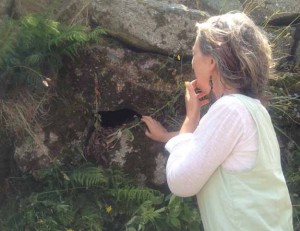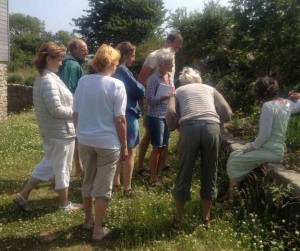Pat attended a presentation by Brigit Strawbridge recently at the beautiful holiday cottage complex of Little White Alice near Stithians Lake. Here’s what she had to say about the day.
Brigit is totally besotted by bees and has become so fascinated and concerned for their plight that she has begun a crusade to educate as many people as possible to become aware of the dire situation and do something about it. The bee awareness talk started with some facts – how many types of bee did we know? I said four, but I was hopelessly wrong!

Bees can be categorised into three broad groups:
– The honeybee (Apis mellifera) is a social bee that forms large colonies that overwinter. It can be kept in hives and is the source of honey and beeswax. A strong honeybee colony may contain about 60,000 bees.
– Bumblebees (Bombus spp.) are also social bees but their nests die out in late summer or early autumn. There are about 24 bumblebee species in Britain but only about 12 are commonly seen in gardens. At peak strength in midsummer, a bumblebee nest may contain up to 200 bees.
– There are about 260 species of solitary bee in Britain, some of which are rare species confined to restricted habitats. Common types of garden solitary bees include some of the Andrena, Osmia, Megachile, Lasioglossum and Nomada species. Solitary bee nests are even smaller and with these non-social bees, each female constructs and provisions her nest on her own.

We learnt about lifestyles of each one, organisation of colonies, nesting sites for bees in the wild, life cycles and job sharing, how amazing their skills, knowledge and communication are, the difference between pollen and nectar and so much more…
The talk was really informative and inspiring, and made me want to go away and find out more. Most of us have seen in the press that bee numbers are declining for a variety of reasons, but I certainly was not aware of how seriously their numbers have declined in recent years. There are several reasons for this sudden decline:
– Loss of habitat – 98% of our wildflower meadows have disappeared and our obsession for neat and tidy gardens has removed all trace of wildflower/weed food sources
– Farming monoculture – growing the same crop year after year
– Increasing population and pressure on wild habitats
– Use of pesticides, especially Neonicotinoids which get into sap, nectar and pollen.
So what can we do about it? There are lots of things we can all do to help bees, for example:
– Provide nest sites for solitary bees: some will nest in hollow stems, such as bamboo canes or herbaceous plant stems. Hole diameters in the range 2-8mm (up to 1/3in) are required. Cardboard nest tubes can be bought in garden centres. Holes 2-8mm (up to 1/3in) diameter can be drilled in fence posts or logs. Place these nest sites in sunny positions. Some solitary bees nest in the ground, either in bare soil or short turf. They will find their own nest sites, so tolerate the small mounds of soil deposited by the female bees when they excavate their nest tunnels.
– Provide nest sites for bumblebees: bumblebee nest boxes can be purchased but they are often ignored by queen bumblebees. They prefer to find their own nest sites down tunnels dug by mice or in grass tussocks. The tree bumblebee, Bombus hypnorum, has recently colonised Britain and will often use bird nest boxes.
– Grow flowers that bees like: Honeybees are active from late winter to autumn, so try and have bee-friendly plants in flower for as much of that time as possible. The Pollinator Garden is a great source of information about plants, pollinating insects and nature friendly gardening, as is The Co-operative’s Plan Bee campaign.
– Don’t use pesticides
– Join the Bumblebee Conservation Trust who are working towards a future in which our communities and countryside are rich in bumblebees and colourful flowers, supporting a diversity of wildlife and habitats for everyone to enjoy.

We have always farmed Bosinver in an organic way without use of fertiliser or pesticides and are proud of our wildlife corridors and wildflower meadows, but I know we can do more. Reassuringly I spent a while looking in our fields today and saw four species of bumblebee working away in a stand of lovely red bartsia – I got a real buzz from that!
So I am inspired – I am going to do what I can to help these amazing creatures and end on a sobering thought… Albert Einstein famously said: “If the bees disappeared off the surface of the globe, then man would only have four years of life left. No more bees, no more pollination, no more plants, no more animals, no more man!”
If you’d like to find out more about bees then check out the International Bee Research Website for free downloadable leaflets and answers to FAQs. Nature-loving kids might like to take a look at the Bumble Kids section on the Bumblebee Conservation Trust’s website.














